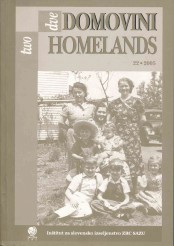THE SUBJECTIVE REALITY OF MIGRATION PROCESSES: TO READ, LISTEN TO AND TO UNDERSTAND MIGRANTS’ EXPERIENCES
Keywords:
migrants’ correspondence, subjective reality of migrants' experiences, social organization of migration, oral history, contextuallyAbstract
The correspondence of the family Udovič-Valenčič-Hrvatin span over many decades among the mother Helena and her youngest son Ivan in Jelšane (Slovenia) and her other three children who emigrated to Americas. Her son Josip left for Cleveland in 1923 and her daughter Pepica joined him in 1930. Her oldest son Anton left for Buenos Aires (Argentina) in 1926. In the text I presented the correspondence from the period between 1930, when Pepica left home and 1940, when mother Helena died. The letters were exchanged mainly between Pepica and mother Helena, though all members of the family were involved.
I find the correspondence intimate and emotional on one hand and restrained and reserved on the other. It is emotional where they write about how much they love and miss each other, regardless if the letter was written by the mother, the son or the daughter. And it is restrained when they write how difficult and miserable life conditions were, no matter if the letters were written in Cleveland, Buenos Aires or Jelšane. They all tried to make the decade of economic depression and political oppression look bearable and manageable. In this regard, it is interesting that the correspondence shows almost no descriptions of the social context of the USA or Argentina. There are no descriptions of everyday life, people, habits, culture in these far away lands. There are, on the other hand, a lot of descriptions of the encounters with the people from the same village and Jelšane local area who were also immigrants. Sometimes it looks they lived very much similar life as they would have lived it back home.
However, I included in the analysis of the family correspondence the narratives of Pepica’s children, which I collected and taped in Cleveland in 2002. From their naratives a very different picture emerged. They described their mother as very involved with the Slovenian language, culture, tradition and community. At the same time, they described her also as a modern, English speaking woman, who sent them to the summer art courses at The Cleveland Museum of Art. Here I show how valuable is the combination of the migrants’ correspondence and the oral history for the understanding of the migration processes. It provides a broad picture and insight of migration experiences of individuals and their families at home and at home away from home from different perspective: the immigrants are not seen as clusters of aliens defined by their ethnicity and working capabilities but as individuals, who made the decisions in different ways and achieved different results.
The correspondence offers an important material for the research of the subjective reality of Slovenian migration processes. It shows that the participants of the migration process – those, who left and those, who stayed – were active, dynamic individuals, who made ambitious decisions taking into account the historical circumstances, but also their personal preferences. The migration correspondence is together with the oral history, life stories and interviews, an indispensable source of relevant information on the intimate perception of the world – the “new” and the “old” one.
Downloads
Downloads
Published
How to Cite
Issue
Section
License

This work is licensed under a Creative Commons Attribution-NonCommercial-NoDerivatives 4.0 International License.
Authors guarantee that the work is their own original creation and does not infringe any statutory or common-law copyright or any proprietary right of any third party. In case of claims by third parties, authors commit their self to defend the interests of the publisher, and shall cover any potential costs.
More in: Submission chapter





